The 9 Asphalt Shingle Roof Components
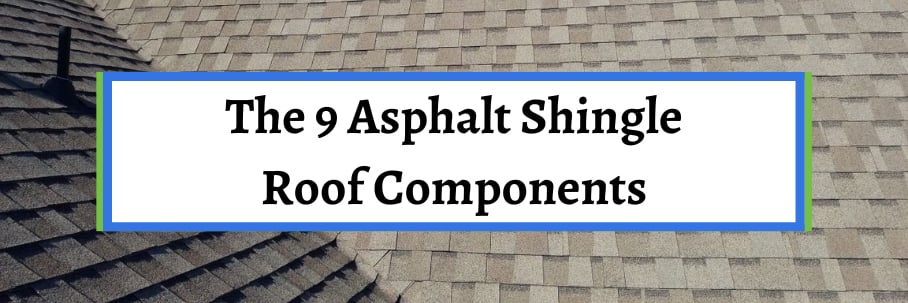
When most people think about an asphalt shingle roof, they think about asphalt shingles. Which is understandable because it’s literally in the name.
The truth is an asphalt shingle roof is a combination of different components coming together to complete an entire roof system. But why is this important to know?
Not only does each one impact the cost, but leaving even one component off your roof estimate can lead to a roof leak. The last thing you want is to have your investment ruined because a roofing contractor didn’t install a crucial component.
This article helps you avoid this happening to your new asphalt roof.
For over 30 years, the team at Bill Ragan Roofing has helped homeowners understand the ins and out of their roofing project. Because of this, I’ll break down the asphalt shingle roof components and why they’re important.
This article covers the following asphalt shingle roof components:
- Roof decking
- Drip edge
- Underlayment
- Ice and water shield
- Roof flashing
- Asphalt shingles
- Ridge capping
- Roof vents
- Pipe boots
1. Roof decking
Roof decking (also called roof sheathing) is the wooden boards (plywood or planks) that make up the foundation of your roof system. Decking is the groundwork of your entire roof system that the rest of the components in this article are installed on.
There are two types of roof decking: plank decking and sheet decking. Plank decking is made up of elongated and rectangular wooden boards that come in either 1x6 or 1x8.
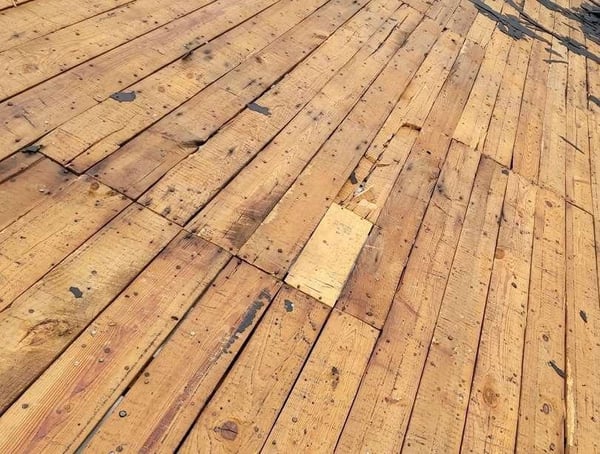 (Plank roof decking)
(Plank roof decking)
Sheet decking (or sheathing) is literally flat sheets of wood, either plywood or OSB.
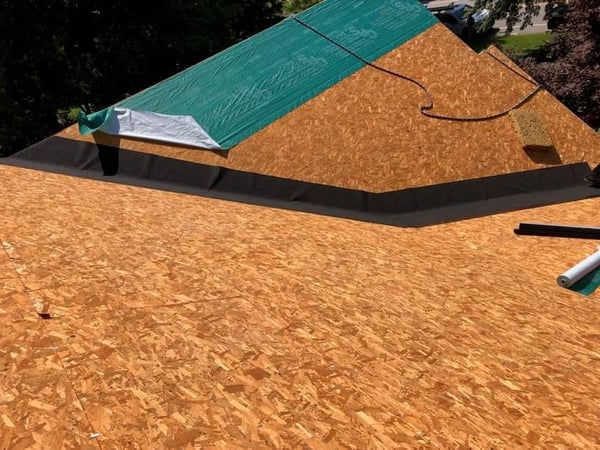 (OSB sheet decking)
(OSB sheet decking)
OSB (oriented strand board) is made up of wood chips/strips compressed together to form a flat 7/16” sheet. Plywood comes in several different thicknesses (⅜”, ½”, ⅝”, and ¾”) depending on the span of the rafters.
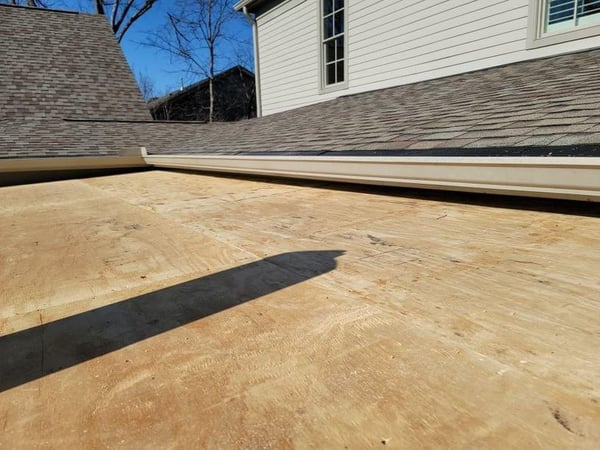 (Plywood roof decking)
(Plywood roof decking)
If your roof’s decking is rotten or can’t handle your new asphalt roof, it’ll need to be replaced before installing the rest of the components. But just know that your roofing contractor can’t tell how much will need replacing until after the tear-off process is complete.
2. Drip edge
Drip edge is metal flashing installed at the asphalt roof’s edges (eaves and rakes) to keep water from getting underneath your roofing components. If it’s left off during your asphalt roof replacement, your fascia board and roof decking will rot from continued exposure to water.
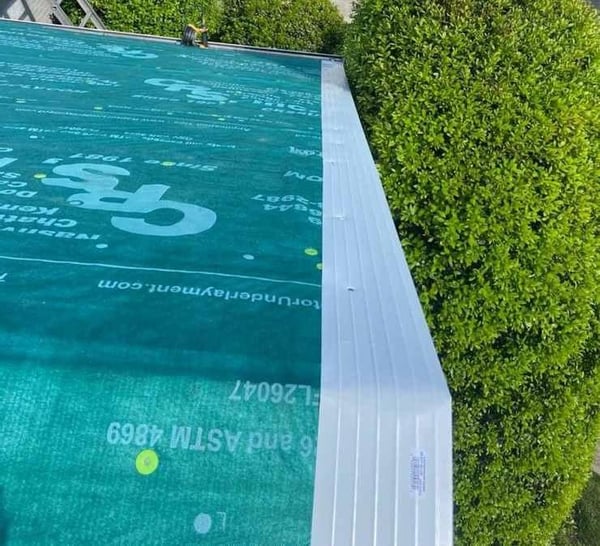
If the threat of damage isn’t enough, Installing drip edge at the rakes and eaves is a required building code. While your home needs it to pass an inspection, it also must be installed correctly as well.
I see too many roofs without drip edge because some roofing contractors leave it off to lower their prices. If there isn’t a line item for drip edge on your roof estimate, you need to make it known or find another roofer altogether.
3. Roof underlayment
Roof underlayment is installed between your roof decking and your asphalt shingles to provide an extra layer of protection. If water happens to get underneath your asphalt shingles, the underlayment is there to protect your roof decking.
There are two different types of underlayment: felt and synthetic.
Felt underlayment has been around the roofing industry longer and comes in 15 lb and 30 lb rolls. Both types do the job, but 30 lb felt underlayment is thicker, stronger, and less likely to tear than 15 lb.
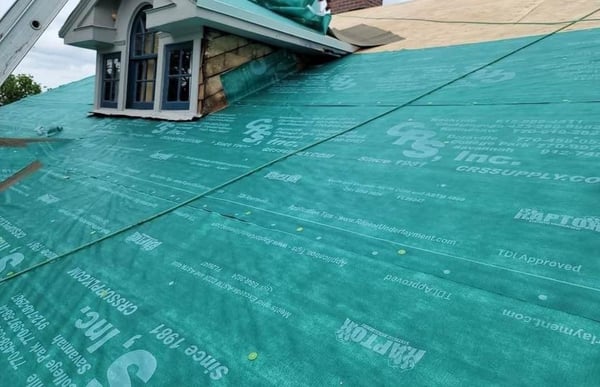 (Synthetic underlayment)
(Synthetic underlayment)
Synthetic underlayment is made out of woven/spun polyethylene or polypropylene. It’s more durable, holds nails better, and repels water better than felt underlayment.
As I said, both types of underlayment do the job. However, I recommend investing in synthetic underlayment's extra protection and functionality.
4. Ice and water shield
Ice and water shield is a waterproof membrane that protects your roof from ice and water damage. Just like underlayment, its main purpose is to protect your roof decking from water getting under your roofing material.
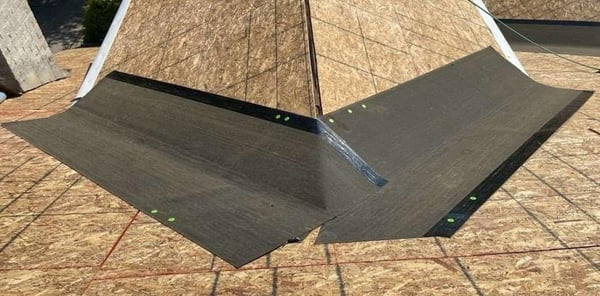 (Ice and water shield in valleys)
(Ice and water shield in valleys)
While underlayment is installed directly over the decking, ice and water shield is installed on/around areas that need a little more protection. These problem areas include roof valleys, around roof penetrations, and roofs that have a 2/12, 3/12, or 4/12 pitch.
Just know that there’s also a building code for ice and water shield if you live above the snow line in the US. The code requires installing ice and water shield along the edges of your roof to prevent leaks caused by ice damming from built-up snow or ice.
.jpg?width=600&name=IceandWaterShieldUpgrade%20(2).jpg) (Ice and water shield around the rake and eaves)
(Ice and water shield around the rake and eaves)
Because of this, you’ll have 2 rows of ice and water shield along your roof’s rakes and eaves to ensure it complies with local codes. Doing this in areas like Middle Tennessee is considered an "upgrade" to prevent ice damming leaks when we get heavy snowfall.
5. Roof flashing
Roof flashing is metal that directs water away from certain areas (walls, chimneys, roof valleys) of your roof. While all the components in this article are important, roof flashing is probably one of the most important when it comes to preventing leaks in potential problem areas.
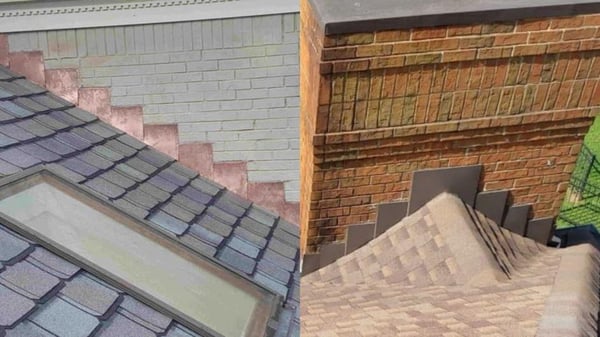 (Left: copper roof flashing; Right: steel roof flashing)
(Left: copper roof flashing; Right: steel roof flashing)
Without roof flashing, you’ll definitely have roof leaks. There are different metal options for roof flashing, most commonly aluminum, steel, and copper.
Today, steel is the most popular choice for residential asphalt roof systems and fits most budgets. But if you want an upgraded look, copper looks great aesthetically but is more costly upfront.
No matter which type of metal you choose, it should outlive the other roofing components. However, you should always replace your roof flashing during your roof replacement.
This is to prevent future problems and ensure all of the components are the same age.
6. The asphalt shingles you choose
This one is pretty obvious, but your asphalt shingles are a big part of your asphalt shingle roof. Your asphalt shingles are the top layer visible to the outside world and make up the bulk of your roof.
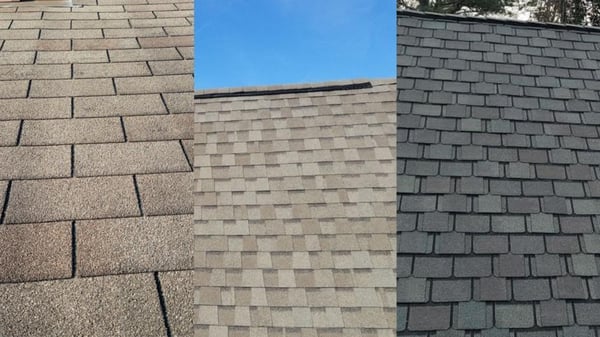 (Left to Right: 3-tab, Architectural, Luxury)
(Left to Right: 3-tab, Architectural, Luxury)
There are three types of asphalt shingles to choose from, 3-tab, architectural, and luxury. Each type of shingle has different warranties, lifespans, and price points.
The great thing about asphalt shingles is that there are plenty of color and style options to fit any budget. Just know that the type you choose has a huge impact on the final cost of your asphalt shingle roof replacement.
7. Ridge capping
Ridge capping is installed where two roof slopes meet at the very top, also called the ridge. Your asphalt shingle roof needs ridge capping to seal it at the top.
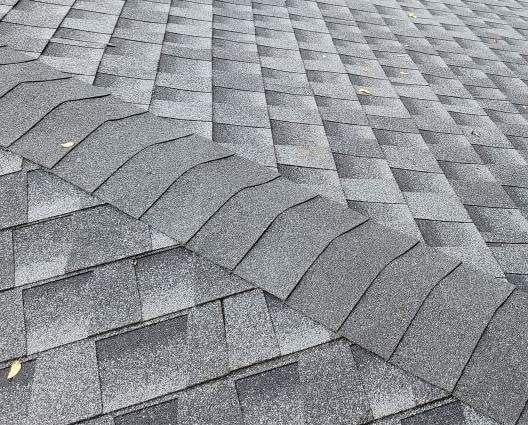
Ridge capping comes pre-bent to form perfectly to a roof’s ridge. Unfortunately, some roofing contractors try to avoid using ridge capping by instead using 3-tab shingles to keep their costs lower.
3-tab asphalt shingles aren’t meant to be used this way. This leads to a roof leak if a roofing contractor decides to go this route.
8. Roof vents
Roof vents ensure your attic and home “breathe” properly. There are two ventilation systems (active and passive) that have different roof vents options to choose from.
For an active ventilation system, you’ll choose turbine vents, power vents, ridge vents with a baffle, or solar-powered vents. For a passive ventilation system, you choose from static vents (box vents), ridge vents without a baffle, or gable-end vents.
I always recommend an active ventilation system to homeowners simply for performance reasons. But no matter which one you have, it means nothing if your attic isn't vented properly.
Not only will it drastically shorten your asphalt roof’s lifespan, but your energy bills will also increase without proper attic ventilation.
9. Pipe boots
Roof pipes need something around them to ensure water doesn’t run down the pipe and get into your home. That’s why pipe boots were invented.
.jpg?width=600&name=PipeBoot%20(2).jpg)
A pipe boot is a synthetic rubber boot that goes around the base of certain roof penetrations to prevent leaks. Your pipe boots must be replaced when getting a new asphalt roof.
Just know that pipe boots crack over time and lead to one of the most common leaks a roofing contractor sees. Because of this, it’s absolutely crucial to have your pipe boots inspected regularly through roof maintenance.
How do you choose the right asphalt shingle?
Now you know the components that make up an asphalt shingle roof. Every one of these components impacts the cost of your new asphalt roof, but not as much as the asphalt shingle you choose.
That’s why it’s crucial to make the right decision when looking at your options. But do you have the confidence to make this decision on your own?
If you answered no, you’re not alone, and that’s nothing to be ashamed of. Most homeowners simply don’t have the information needed to decide, let alone the right one.
That’s why I wrote another article that helps you choose the best one for your specific situation.
The team at Bill Ragan Roofing has provided high-quality asphalt roof replacements to thousands of homeowners in Nashville and surrounding Middle Tennessee areas since 1990. You can count on us to do the job right, and we back up our workmanship with a lifetime guarantee.
Check out How Do I Choose My Asphalt Shingle to learn how to make the right asphalt shingle purchasing decision.


